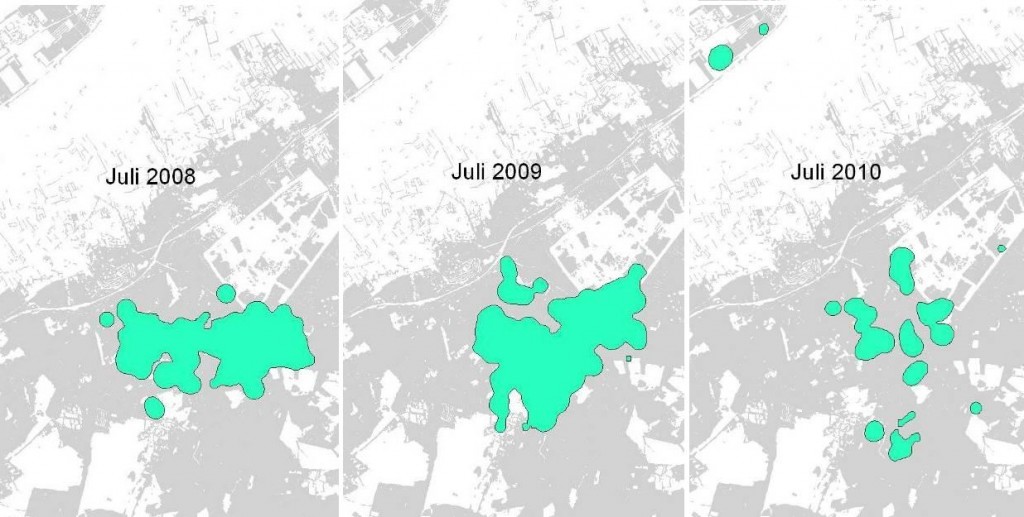
Being a forest dwelling species, we were unsure about the applicability of solar energy fed GPS loggers on Honey Buzzards. As the results from our first 2008 males turned out positive, we applied 14 loggers till 2010 (6 females). Problems with battery power mainly arose during cool cloudy weather and for incubating females as they apparently were much less areal when off duty than their mates. We calculated from continuous VHF tracking that a 10 minute GPS-resolution is ideal for interpreting data. For battery saving or download purposes we periodically switched to 20-30 minutes.
The first aim of this study was to establish habitat-use and preference in order to motivate habitat management schemes within the Natura 2000 framework. Yet data provides the opportunity to study a much wider scope of relevant ecological issues, like between-year variation linked to weather.
Results
True Honey Buzzard arrival dates provide a new measure in breeding studies. Male arrivals were between May 6th and 20th, soon to be followed by their females. On average, laying started two weeks after male arrival. Onset of reproduction thus appears closely linked to spring arrival and migration speed. Laying date determines quality of reproduction. Birds starting before 25th of May produce chicks with best growth rates and survival.
Breeding males expand their feeding ranges as the season progresses, with feeding trips over 5 km, although the optimal feeding distance seems to be only 2 km1. Females increase their feeding range from chick-age 12-14 days onward when frequent brooding is no longer required. They range even further than males with frequent trips over 10 km.
On poor dry soils, birds favour mature pine stands with broad-leaved understory for feeding. These are the stands with a better developed, nutrient-rich soil profile. When moving to richer soils with a higher water table, Honey Buzzards favour broad-leaved stands.

In years with few wasps, the larvae of which form the main food of Honey Buzzards (2010 as opposed to 2008-09), average feeding ranges show a wider scatter earlier in the season. Nestlings are more frequently left without protection at a younger age. This inflicts higher predation losses and reduces reproductive output.
As the project continues we hope to be able to fine-tune our analysis of habitat use respecting individual variation.
GPS and VHF techniques
Ideally we would have combined GPS and VHF techniques in one bird to get insight in behavioural details. For ethical and practical reasons we have chosen to apply only one technique per individual. VHF data generated from continuous tracking were used to calibrate our algorithms for GPS interpretation. To validate our observation we filmed with hidden cameras at nests and prey sites. Stills and film show the same female, in a film clip (August 14, 2010) as she successfully harvests, snaps wasps, eats larvae and prepares the transport of a large Vespula germanica comb.

Contact persons, funders and participants
Willem van Manen, willemvanmanen@boomtop.org
Jan van Diermen, diermenjan@gmail.com
Willem Bouten, University of Amsterdam Institute for Biodiversity and Ecosystem Dynamics / Instituut voor Biodiversiteit en Ecosysteem Dynamica (IBED) w.bouten@uva.nl
Publications
1 Van Diermen J., Van Manen W. & Baaij E. 2009. Habitat use, home range and behaviour of Honey Buzzards Pernis apivorus tracked on the Veluwe, central Netherlands, using GPS. De Takkeling 17(2): 109-133. (in Dutch with captions and summary in English).
2 Van Manen W., Van Diermen J., Van Rijn S. & Van Geneijgen P. 2011. Ecology of Honey Buzzard in the Veluwe Natura 2000 site (central NL) during 2008-10, population level, breeding biology, habitat use and food. Natura 2000 report Province of Gelderland, Arnhem NL / Boomtop foundation www.boomtop.org Assen NL. (in Dutch with captions and summary in English).
